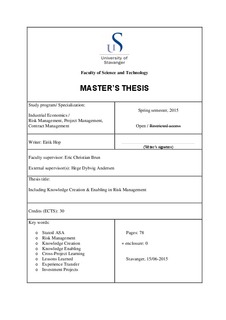| dc.description.abstract | As a contribution to Statoil Technical Efficiency Programme (STEP), has the thesis looked at how to improve the risk management process in Statoil ASA. Through theoretical research was the primary research question created:
“How can knowledge creation & enabling improve our understanding of risk management?”
To create a theoretical foundation, the thesis looked at principles, methods, and models for the adequate assessment and management of risk. This includes a new perspective on risk that emphasizes the combination of probability-based thinking, a knowledge dimension, and surprises (black swans).
In addition, to be able to understand how knowledge could improve our understanding of risk management, different theories were studied. The theory of knowledge creation & enabling was used, as this emphasizes knowledge enabling activities to be able to create knowledge at different steps. These knowledge creation steps are; sharing tacit knowledge, creating a concept, justifying a concept, building prototypes, and cross-leveling knowledge. Knowledge cannot be managed, and must be enabled through; instill a knowledge vision, manage conversations, mobilize knowledge activist, create the right context, globalize local knowledge.
Through interviews, observations and documentation was Statoil ASA used as a case study. This was to test the hypothesis of a close connection between knowledge creation & enabling and Statoil’s risk management process.
Each of the knowledge creation steps was analysed in a Statoil ASA context, which was investment project’s risk identification/assessment meetings and workshops. Knowledge enablers were used to look at ways to improve their risk management.
Further, findings from the case study were discussed in a more theoretical perspective. The thesis discussed how knowledge affects the risk management process and more specifically how each of the enablers affects risk management.
The thesis concludes that there is a close connection between risk management and knowledge creation & enabling. The case study demonstrated that knowledge enablers already are a part of the risk management process. However, the organisation was not conscious of it, and a focus on it may improve their risk management process.
Through the analysis, a few improvements for Statoil ASA were suggested. These suggestions surfaced from the use of knowledge enablers, and may improve how risk is understood in the project team. It may improve the project team’s knowledge to better identify and assess risks, and how knowledge of the risks are cross-leveled between investment projects. | nb_NO |

